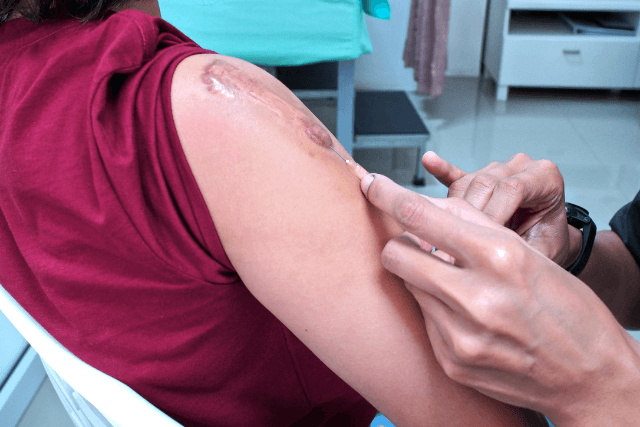Treatment for Keloids is more than just a cosmetic concern. In fact, keloids often bring both physical and emotional stress. These scars rise above the skin, extend beyond the original wound, and sometimes cause pain or constant itching. As a result, many people feel self-conscious about their appearance. Additionally, untreated keloids may continue to grow, making early care essential.
In this blog, you will discover evidence-based ways to manage keloids, reduce their size, and lower the risk of recurrence. First, we will explore what causes keloids. Next, we will move step by step through treatment methods, beginning with simple preventive approaches and moving toward advanced combination therapies. Finally, we will summarize the best strategies so you can feel confident about your skin health.
By the end, you will understand not only how different treatments work but also why one option may be chosen over another. Most importantly, you will see how using several treatments together often delivers the best long-term results.
Understanding Keloid Causes and Why Treatment Matters
Keloids appear when the body produces too much collagen during wound healing. Instead of stopping once the skin has closed, the body continues building scar tissue. Consequently, the scar becomes thick, raised, and larger than the original wound.
Keloid causes vary, but they often include surgical cuts, ear piercings, acne scars, or even small injuries such as insect bites. Moreover, people with darker skin tones, particularly those of African, Asian, or Hispanic backgrounds, have a higher risk of developing keloids.
Why does treatment matter so much? Because keloids rarely go away on their own. Left untreated, they can enlarge over time. Furthermore, the constant itching and tenderness may disrupt daily life. Many individuals also report feeling embarrassed, which can reduce self-esteem. Therefore, finding the right treatment for keloids is important not only for appearance but also for quality of life.
Silicone Sheeting and Early Prevention
When it comes to early care, silicone sheeting remains one of the most recommended options. This method involves placing a thin, flexible sheet of medical-grade silicone directly on the scar. Over time, the sheet locks in moisture, reduces collagen buildup, and helps flatten the scar. Similarly, silicone gels applied as a thin coating can work in the same way.
The greatest advantage of silicone sheeting is that it is simple, noninvasive, and painless. Additionally, it can be used right after the wound heals, which means prevention begins early. Many dermatologists encourage patients to wear silicone sheets for at least 12 to 24 hours a day, often for several months.
Besides silicone, pressure dressings or garments can also play a role. These garments apply steady pressure to the scar, reducing blood flow and limiting growth. For instance, burn patients are often advised to wear pressure garments to prevent keloid formation.
In short, silicone sheeting combined with pressure therapy is an excellent first step in the treatment for keloids. While these methods may not always shrink very large scars, they can prevent early scars from worsening.
Steroid Injections and Their Role
Once a keloid has formed, steroid injections often become the next line of care. Doctors typically use triamcinolone acetonide (TAC), injecting it directly into the scar. This approach reduces inflammation, slows excess collagen production, and gradually flattens the keloid.
The process usually requires several sessions, spaced about four to six weeks apart. After each session, patients often notice that the scar becomes softer, smaller, and less itchy. In addition, the color of the scar may fade, making it less visible.
However, steroid injections are not perfect. Recurrence rates remain around 50 percent when used alone. Furthermore, side effects such as skin thinning, changes in pigmentation, or visible blood vessels can appear. Therefore, while steroid injections are helpful, they often work best as part of a broader combination treatment plan.
Combination Treatment for Better Results
Because keloids are stubborn, experts now recommend combination treatment rather than relying on just one method. For example, if a doctor removes a keloid surgically, the scar often grows back. In fact, surgery alone can lead to recurrence rates of up to 100 percent. But when surgery is followed immediately by radiation therapy or steroid injections, recurrence drops sharply.
Radiation therapy, when applied within one or two days after surgery, can reduce recurrence to below 20 percent. Some reports even show rates as low as 3 to 6 percent. Similarly, surgery followed by steroid injections, or surgery paired with pressure therapy, provides stronger protection than surgery alone.
In addition, intralesional excision, which removes most but not all of the scar, has shown lower recurrence compared to traditional removal. This is because leaving a thin rim of keloid tissue at the edges may prevent the skin from “overreacting” and forming an even bigger scar.
Therefore, if you are considering removal, it is wise to choose combination treatment for keloids. This strategy not only improves appearance but also reduces the stress of repeated recurrences.
5-FU Injections and Other Medical Options
Besides steroids, doctors may use other injectable medications. One of the most studied is 5-fluorouracil, also called 5-FU. This medication, injected directly into the keloid, slows down the activity of scar-forming cells. Patients often receive it in combination with steroids, which increases success. Studies show that recurrence rates drop significantly with this approach.
Bleomycin and verapamil are two additional injectables that sometimes help. Although not used as commonly as 5-FU, they may be considered in special cases.
Another option involves topical medications. Imiquimod cream, for example, boosts the skin’s immune response. When applied after surgery, it can sometimes reduce recurrence. Mitomycin C is another topical agent, though its use is limited due to possible side effects.
While these treatments may not work for everyone, they highlight how diverse the options have become. Thus, patients and doctors can design a personalized plan based on scar size, location, and past treatment response.
Laser Therapy and Cryotherapy
When scars remain thick and raised, additional procedures like laser therapy can help. Pulsed dye laser is a common choice. It targets the blood vessels that feed the keloid, which reduces redness and thickness. Over time, the scar becomes flatter and lighter in color.
Laser therapy often works best when combined with steroid injections. This dual approach attacks both the blood supply and the collagen buildup.
Cryotherapy offers another path. By freezing the scar tissue, doctors can shrink the keloid from the inside out. This method works especially well for smaller keloids, such as those on the ear. However, cryotherapy may cause skin lightening, especially in people with darker skin. To reduce this risk, it is often combined with steroids.
Overall, laser therapy and cryotherapy act as strong add-on treatments that improve both the look and feel of keloid scars.
Choosing the Right Treatment for Keloids
Because no two patients are alike, choosing the right treatment for keloids depends on several factors. These include the size and age of the scar, its location on the body, your skin type, and your personal medical history.
For small, new scars, silicone sheeting and pressure therapy may be enough. If the keloid continues to grow, then steroid injections can be added. For larger, resistant keloids, combination treatment such as surgery plus radiation or injections often delivers the best results.
Importantly, communication with your dermatologist or plastic surgeon matters. They can explain which method is safest, most effective, and most affordable for you. Since keloids often recur, you may need several sessions or a mix of therapies. Therefore, patience and consistency are essential parts of the healing process.
Long-Term Care and Daily Habits
Besides medical treatments, daily habits also play a role in preventing recurrence. For example, always keep wounds clean, moist, and protected during healing. Use sunscreen on scars, because sun exposure can darken them and make them more visible. Avoid unnecessary piercings or tattoos if you know you are prone to keloids.
Furthermore, follow-up visits with your doctor are crucial. Even after successful treatment, monitoring helps detect early regrowth. Starting treatment early makes scars easier to control.
By combining medical care with smart daily habits, you create the strongest defense against recurrence.
Key Takeaways
- Treatment for Keloids is essential for both comfort and confidence.
- Keloid causes include wounds, piercings, acne, and surgery.
- Silicone sheeting is an easy first step.
- Steroid injections shrink scars but work better with other methods.
- Combination treatment lowers recurrence dramatically.
- 5-FU injections, imiquimod cream, and mitomycin C are promising add-ons.
- Laser therapy and cryotherapy improve appearance and symptoms.
- Daily habits, such as sun protection, help maintain results.
Conclusion: Treatment for Keloids
Treatment for Keloids requires patience, persistence, and the right combination of methods. Although no single therapy guarantees success, modern medicine offers many tools to reduce scars and prevent them from returning. From silicone sheeting to advanced surgery with radiation, options now exist for every stage of keloid development.
Most importantly, starting treatment early and working closely with a qualified doctor can greatly improve outcomes. With consistent care, you can reduce discomfort, improve appearance, and regain confidence in your skin.










